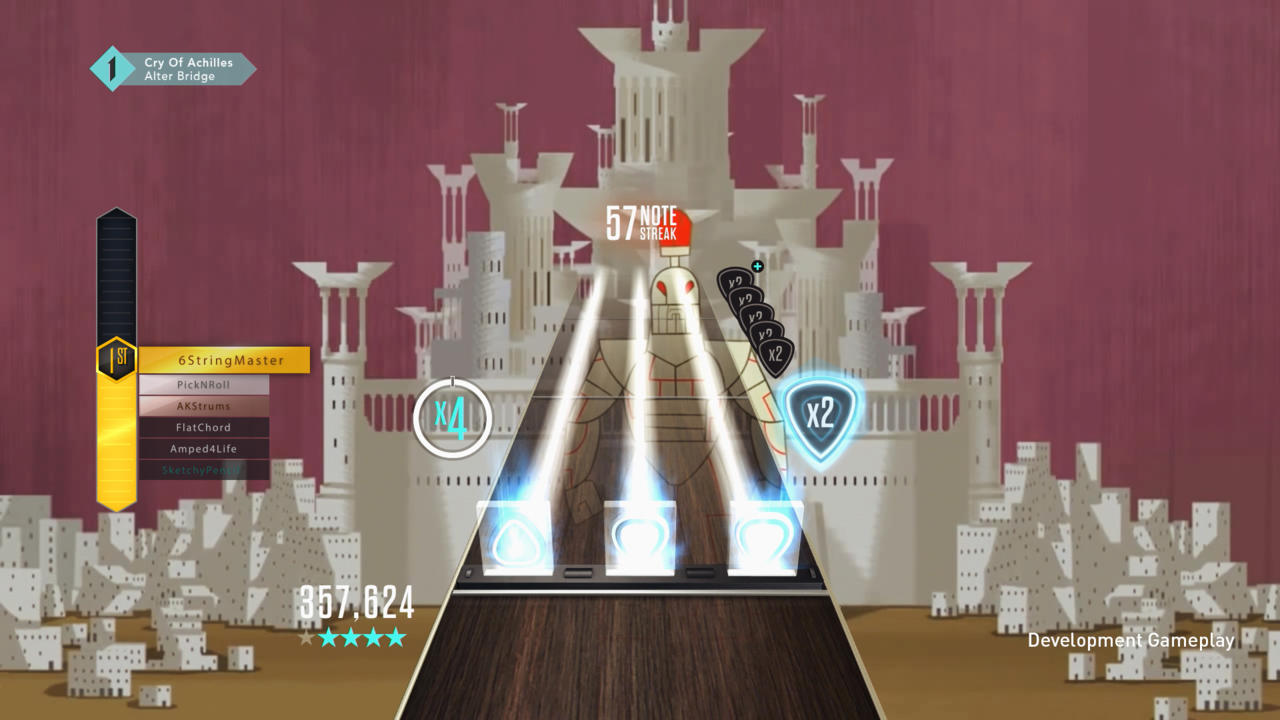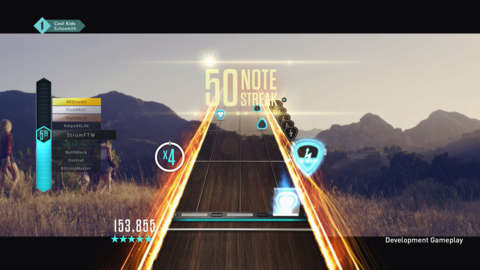Guitar Hero Live is a complex machine with many moving parts and a lot of new ideas. Its visuals rely primarily on live action footage rather than traditional game graphics. Its guitar trades the long-standing five button layout for three pairs of buttons stacked on top of each other. And it delivers new music through a freemium-style service rather than simply selling individual tracks. Some of these new ideas work beautifully, while others fail miserably, which makes Guitar Hero's long-awaited return a consuming, often overwhelming sequence of incredible highs and unbearable lows.
The first of the game's two completely separate experiences is simply called Live, presumably because underneath its standard note highways, it uses real actors and a first-person camera to make players feel as though they're really standing onstage. In theory this should immerse players in the fantasy of playing in front of thousands of fans, but I was generally too focused on the gameplay to notice everything happening in the background. And when I did notice, I frequently cringed. Everything from the costumes to the acting to the unskippable concert intros feels painfully forced and inauthentic. The game absolutely trips over itself to sell you on the idea that you're a totally super cool rockstar. Every single person smiles aggressively with canned enthusiasm while uncomfortably mugging the camera and giving you the most comically exaggerated thumbs up you've ever seen. It's so campy it borders on parody.

And weirdly, crowd reactions come in just two flavors: good and bad. Depending on your performance, you're either an irredeemable embarrassment or an untouchable rock god. There is no inbetween. If you nail every single note for 90 percent of a song but somehow screw up the outro, the video still switches over to the negative take, leaving you to face jeers from the crowd and dirty looks from your band as the next song loads up. Couple that with the obnoxious announcers and bland, and pointless fake Tweets that pop up between songs, quickly the presentation becomes grating. I appreciate Live's attempt to do something truly different--and this new approach did provide a few memorable moments late in the campaign--but the execution spoils what was potentially a cool idea.

Thankfully, Live's other major change pretty much single-handedly redeems the entire game. Its new button configuration fundamentally transforms how the game plays, and delivers some desperately needed innovation to a stagnant genre. By altering the underlying chord buttons to two rows of three, new inventive patterns are added to the traditional scrolling note gameplay, including clever new "chord" formations and intricate variations on hammer-ons/pull-offs. Even seasoned music game vets have to start from scratch, which renews the sense of reward that comes so naturally as your skills develop. The challenge and progress that inform this style of play account for a huge part of the genre's core appeal, so to completely revitalize those qualities is a serious accomplishment.
That said, Live doesn't completely nail this new gameplay right out of the gate. Similar sounds and guitar techniques sometimes manifest differently in different songs, which made the learning process a bit more frustrating. I also occasionally felt like what I was playing didn't meaningfully match what I was hearing, especially at the highest and lowest difficulties. The biggest issue, however, is the music. Tastes are subjective, granted, but even if you love every artist on Live's roster, many of the songs just aren't cut out for Guitar Hero gameplay. Way too often I found myself playing one simple, repeating hook over and over because, honestly, that's how a lot of pop songs are structured. Unlike rock songs, they were never intended to showcase the guitarist. Artists such as Skrillex and Eminem are undoubtedly popular, but their tracks just don't make sense for a guitar-driven experience.
This brings us to Guitar Hero Live's other half: Guitar Hero TV, a music platform that layers gameplay on top of a reasonably sized library of official music videos. At 200-plus songs, it still pales in comparison to Rock Band's extensive back catalogue, but it does crush Live's 42 tracks. And while the campaign's on-disc music consists almost uniformly of Top 40 artists from the past five or so years, GHTV includes beloved six-string standards like Weezer, The Clash, and Pantera. I had to dig them out from under a pile of newer releases from the likes of Avril Lavigne, but I did eventually locate them.

But-there's a catch: Any time you seek a song from the Now Playing section (i.e. a song you actually want to play), you have to spend a form of in-game currency called a Play. A 10-pack of Plays will only cost you $2.50 and you can buy unlimited plays for 24-hours for $6, but you can easily avoid spending money altogether by earning in-game currency while playing GHTV's two free "Channels," which--like the ancient days of MTV--play a constant, pre-programmed stream of music videos that you can jump in and jam along with.
So unless you pay with money, you're essentially paying with your time and attention, and being forced to play songs the game chooses on a predetermined schedule isn't really what I want out of a music-driven experience. Plus, burning through songs like that makes the music feel more disposable. The first time you play a track is often the last time you play that track unless you go out of your way to hunt through menus to find it. That's fine when the song is awful, but it's also a little sad. At least you also earn chunks of free Plays periodically just for playing the game at all, although there is no way to permanently unlock a song no matter how badly you want unfettered access to your favorite tunes.
There is no way to permanently unlock a song no matter how badly you want unfettered access to your favorite tunes.
Regardless, you can technically access all of GHTV's music without spending any cash. If you want to spend money, the rates aren't terrible, and might even make sense for players who used to buy a DLC track and then only play it once or twice. The game grew less and less generous with its free Plays over time, though, so inevitably, you'll have to grind through songs you don't care about or pony up some dough to play the songs you really want. Even worse, it's uncomfortable to even have to consider whether a song is really "worth" a Play or be forced to endure content I don't care about simply to access the content I want. It changed the way I thought about the entire experience, and for me, that lack of freedom undermined a lot of the fun.

It's also worth noting Guitar Hero Live omits a few extras that previous Guitar Hero games consistently supplied. A practice mode, for example, would have made perfect sense given the brand new mechanics, yet there are no learning tools present beyond a mandatory, barebones tutorial. You also won't find drum or bass parts, though you can hook up a second guitar or even plug in a mic and sing. Keep in mind, however, you cannot enjoy the campaign with friends, and you must complete single-player sets to unlock all the on-disc songs before you can select them in Quickplay. Finally, while leaderboards of course return, I didn't see a way to play with friends directly online. While the absence of online multiplayer doesn't bother me, I know it may affect others' opinions.
Guitar Hero Live's reinvented mechanics makes music-driven gameplay fresh and fun again, and while that's a truly massive and meaningful change for the genre as a whole, the campaign's off-putting presentation and GHTV's unpleasant microtransactions all sour the experience built up around that gameplay. Still, this successful innovation alone might be reason enough to grab a new axe and rock out regardless.